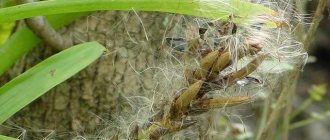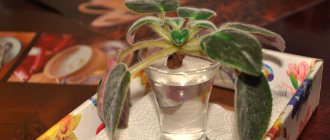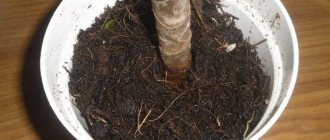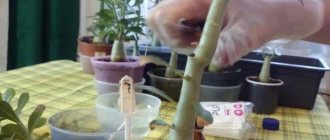Although phalaenopsis is considered almost the most unpretentious representative among indoor orchids, there are still certain subtleties and nuances in its cultivation. This is especially true for the process of transplanting a plant to a new place, when it is easy to damage.
But you will have to replant the phalaenopsis - at least after purchasing it, because store-bought flowers usually live in small shipping pots. And at home - provided that you have created all the necessary conditions for him to live a comfortable life and he is actively growing, so that he is already cramped in the old pot.
Appearance of a diseased root system
The roots of the orchid may undergo pathological changes. Under such circumstances, the roots of the orchid change their appearance and color. Most often, orchid roots are damaged as a result of putrefactive changes. This process occurs especially often in the autumn-winter period, which is associated with a decrease in ambient temperature and a decrease in exposure to sunlight. Changing conditions can cause a houseplant to go dormant.
External changes may not be noticeable, the leaves will retain their density and absolutely natural color. At this stage, the root system stops absorbing moisture, and the water accumulated in the planting container becomes a factor causing rapid rotting.
When the roots of an orchid die as a result of rotting, the gardener still has a chance to save the indoor plant by performing a number of fairly simple and accessible measures, including pruning.
Preparation for the procedure
Before transplanting, pay attention to the selection of the pot - it should be 3-4 cm more spacious than the previous one. Particular attention is paid to the substrate in which the plant will take root. For young children, fine bark is suitable; for adult orchids, buy a large fraction. The soil can also be made from a mixture of moss, fern roots and tree bark, after calcining the components in the oven.
Before transplanting, the bark is soaked for 10 minutes, then the process of transferring the phalaenopsis into a new container begins.
Important! If the bark was collected in the forest, it is first boiled in boiling water to destroy pests and fungi, then dried
Flower rejuvenation
Old plants can be successfully rejuvenated. If the trunk has become elongated because the leaves below have been naturally dying off for a long time, you can carry out a procedure for rejuvenating the phalaenopsis:
- Cut off the top so that underneath there are air layers and the beginnings of new roots. Treat the area with activated carbon.
- Prepare the substrate or bark.
- Place large pieces of bark on the bottom of the pot.
- Place a piece of foam plastic under the cut area - this technique prevents moisture from entering the cut area and rotting.
- Place the orchid and sprinkle the sides with fine bark for stability. The bark should cover the place where the root buds are located so that they begin to grow faster.
The rest of the plant with roots can also be cleaned and left in the substrate. Soon a new rosette of leaves will grow from it.
How to know which roots need to be cut and treated
A healthy orchid root system is covered with a special spongy substance, velamen. This integumentary tissue performs a respiratory function and also supplies plants with gaseous nutrients. Healthy roots have:
- regular cylindrical shape, the same along the entire length,
- durable turgor.
- bright green color.
It is normal for a whitish coating to appear. This means that the plant needs to be watered.
But if dots, spots or islands of yellow, brown or black color are visible on the surface of the roots, then something is wrong with the orchid.
In addition to visual analysis, you can determine the condition of the roots by touch:
- Press lightly on both sides with two fingers. A healthy process is dense and elastic.
- If sap or mucus comes out and the tissue becomes wet and slippery, the root is infected and must be removed.
To save an orchid, diseased roots need to be cut off and the plant replanted in a fresh substrate.
FAQ
Orchids are quite capricious flowers, and many who want to grow them constantly have various questions and concerns.
Is it possible to disturb during flowering?
A blooming orchid can only be replanted if absolutely necessary:
- affected by rot;
- mold;
- parasitic insects.
The peduncle will have to be removed or partially shortened, otherwise it will not leave the plant the strength to survive and recover. The rest of the procedure follows all standard rules.
Is it possible to replant when the plant has flowered?
Spring and summer are the best time to transplant an orchid, when it has already bloomed. The upcoming warm season and rest period will help to quickly recover from the discomfort experienced and begin the growing season. The peduncle is removed completely or up to the first bud, leaving 2 cm of the stem above it.
If the underground part does not fit completely into the container
The orchid easily tolerates the removal of 1/3 of the root volume . Pruning is carried out on those roots that grow too thickly, compact the overall mass and prevent moisture from entering. The working tool must be disinfected after each new cutting of the appendage.
What to do with a large plant?
For a tall orchid, the diameter of the new container should be related to the size of its root system. A small container will not support the weight of the flower and will definitely tip over. The main rule is a slight crowding, but there is room for roots to grow. When transplanting, a support for the peduncle is installed in advance.
After transplantation, the orchid may take up to six months to adapt. Compliance with the frequency and all stages of this process can shorten the rehabilitation period and resume flowering as soon as possible.
Substrate
The main component of the orchid substrate is tree bark. From constant contact with water, it swells and decomposes, causing the soil to turn into a dense, heavy mass. Negative consequences for the plant:
- decreased air circulation in the roots;
- imbalance of mineral salts;
- increased acidity levels and a decrease in the number of beneficial microbiomes;
- reduction of nutrients in a form available for absorption by the roots.
All representatives of orchids require soil with the following qualities:
- loose and light;
- permeable;
- ecologically pure;
- acidity 5.5-6.5 pH;
- enriched with a complex mineral composition.
There are 2 groups of orchids grown at home: terrestrial and epiphytic. Differences in the growing environment, methods of obtaining moisture and nutrition were reflected in their requirements for soil contents. Epiphytes use the substrate primarily as a support. The mixture must consist of organic and mineral components.
Example compositions:
- bark and charcoal in a ratio of 5:1;
- pine bark, sphagnum moss and ash in proportions 5:2:1;
- for seedlings and young orchids - 4 parts of fine bark, 1 part perlite and ash.
Expanded clay and dry fern roots are used as additional components.
Terrestrial orchids - cymbidium and paphiopedilum. These species require increased nutrition. For the classic mixture, take in equal parts:
- high peat;
- pine bark;
- crushed charcoal;
- moss;
- leaf humus or sterile turf soil.
We invite you to watch a video about the types of substrates for growing orchids:
After care
Caring for an orchid after planting is an important part of the process, on which the further growth of the flower depends
To complete the process of replanting an orchid, proper care plays an important role:
- Be sure to move the pot after planting the plant to a shady place, limiting the intensity of sunlight.
- The optimal air temperature is 20 °C-22 °C.
- It is recommended to place the orchid on the windowsill on the east side.
- After transplantation, the first watering is carried out 5 days later.
- Feeding with fertilizers is allowed within a month after changing the substrate.
Chemical fungicides - all the pros and cons
Drugs in this category have a stronger effect on pathogenic microorganisms. Unlike biological agents, they are dangerous. They resort to their help when more gentle options have been exhausted. Despite their high efficiency, chemical fungicides are intended to protect open ground plants. If there is a need to treat indoor orchids, it is better to do this in the garden or on an open balcony. It is important to take all necessary precautions:
- use personal protective equipment,
- remove strangers
- keep the orchid isolated from other plants.
Experts in growing orchids recommend the following drugs for the treatment of measles diseases of orchids:
- “Pure Flower” is produced as a concentrated emulsion, packaged in hermetically sealed ampoules. To treat (soak) the root system of orchids before planting against diseases, prepare a solution - the contents of one ampoule (2 ml) per 5 liters of water. The prepared solution is not stored; it must be used within several hours.
- "Quadris" is a fungicide widely known in open-ground gardening. The drug is effectively developed and produced by one of the world leaders in the production of plant protection products -. Available as a liquid concentrated suspension. The product is designed to combat a large number of pathogens. To treat orchid roots before planting, prepare a working solution - 1 ml of suspension per 2 liters of water.
Getting inside the tissue through sections, it blocks the spread of pathogens. The result appears within 1 hour after treatment.











